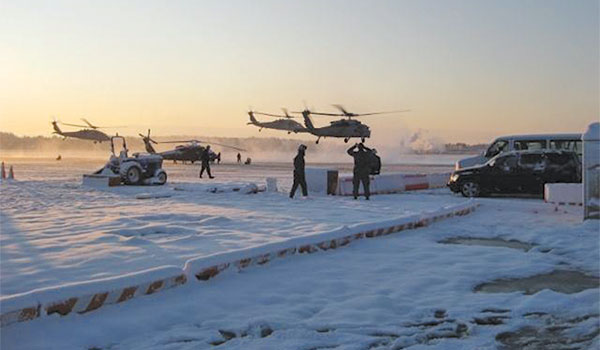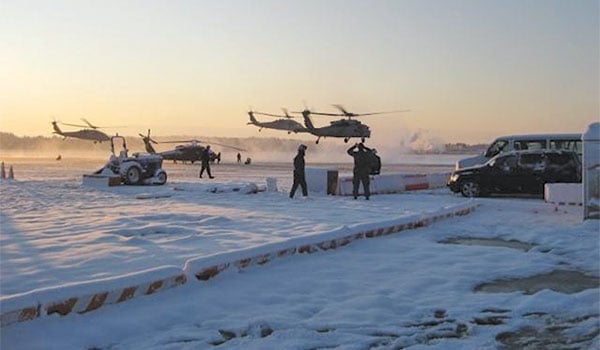
Reserve Component Aviation / By COL J. Ray Davis: One aviation training capability that may surprise some is the roster of ARNG-owned-and-operated Army airfields (AAFs) and heliports (AHPs). Sprinkled throughout the 54 States and Territories, these sites are most often not the bed-down locations of our Guard aviation units, but rather facilities where folks can come to train.

2-111th Airfield Operations Battalion, Florida ARNG, deals with a surprise snow storm at Blackstone Army Airfield, Fort Pickett, Virginia, during Exercise Southbound Trooper 12./ U.S. ARNG PHOTO BY GREG ALEXANDER
Among this list of 47 airfields and heliports, 7 have manned air traffic control (ATC) facilities, and 7 have an instrument approach. Among the 12 airfields, 7 are capable of landing C-17/C-130, 3 have improved unmanned aircraft systems (UAS) landing strips, and 3 have a C-130/C-17 assault strip. Let me highlight just a few (if you want more information, give Greg Alexander a call at 703-607-2098).
Camp Shelby, Mississippi, hosts the Joint Forces Training Center (CSJFTC) and Hagler AAF, which have multiple training areas and ranges supporting rotary- and fixed-wing aircraft, as well as UAS operations. As the Nation’s largest National Guard training center, CSJFTC has a vast maneuver space that includes a 3,500-foot C-17 tactical assault strip, 340 square kilometers of Restricted Airspace (R-4401), and a multipurpose range complex that supports aerial door gunnery qualification for cargo and utility helicopters. Camp Shelby is a popular site for UAS training as well. Several launch and recovery locations are established within restricted airspace to support TUAS-Shadow operations, and the CSJFTC is capable of supporting manned-unmanned teaming with its tenant Shadow Platoon and any on-site attack/reconnaissance aircraft. Due to the high volume of C-17, C-130, fighter and UAS traffic, a permanent Airspace Information Center (AIC) is in development to manage and implement airspace procedural control, as well as deconflict ground and air operations. The AIC will also serve as a training and certification facility, providing training opportunities for ARNG air traffic controllers.
Keeping air traffic controllers well-trained requires an ATC facility and aircraft movements. Blackstone AAF, managed by the Virginia ARNG and Fort Pickett, provides one such resource. It’s a joint use (military/civilian) airfield that provides ATC tower services and Class D airspace. During one recent training event involving multiple commands, a total of 197 C-17 sorties were scheduled, generating nearly 11,000 aircraft movements (both day and night), and over 1,320 ATC training hours. Blackstone AAF has often hosted Exercise South Bound Trooper (SBT), a joint training event executed by Canadian, British, Australian, and U.S. troops. This training event afforded the Florida ARNG airfield operations battalion (AOB) pre-deployment training, where they were invited to manage an airfield in preparation for deployment. The unit deployed their ATNAVICS radar, integrated their Tactical Airspace Information System (TAIS) into the Airspace Management Cell, managed Blackstone’s airspace, and deployed the ATC TAC Team in support of infantry and artillery missions.
ARNG airfields provide a great opportunity for DOD and Government agencies to link up and conduct integrated training. Located at Camp Guernsey, Wyoming, Guernsey AAF provides air traffic control and airfield management support to all branches of service, other government agencies, and local organizations. Capable of landing C-17 aircraft, the airfield and the installation supports 18 USAF flying units, 13 Army Aviation units, 8 USMC flying units, and 5 flying OGAs (other government agencies). Within its Restricted Airspace (R-7001) is a 4,728’ tactical landing strip which meets the minimum standard for C-130 operation.
Here are a few more Guard facilities worth noting: n Bryant AAF: located on Joint Base Elmendorf/Richardson (JBER) in Anchorage, Alaska, but managed by the AK ARNG; home to the 1-207th Aviation (ASLT). n Himsel AAF: located at Camp Atterbury, Indiana, provides support to the Air Force Institute of Technology, USMC’s 4th RECON Squadron, and the Muscatatuck Urban Training Center (MUTC). n Los Alamitos AAF: Located in southern California, it is the ARNG’s most robust airfield, and provides support to tenant and transient aircrews, including Presidential Flight Support (HMX-1), and heavy lift cargo operations for NASA.
So, the next time you’re looking for a great place to train, consider some ARNG concrete and asphalt – a lot comes with it.
Fly Safe. Fly Guard.
COL J. Ray Davis is the chief of the Army National Guard Aviation and Safety Division located in Arlington, VA.







